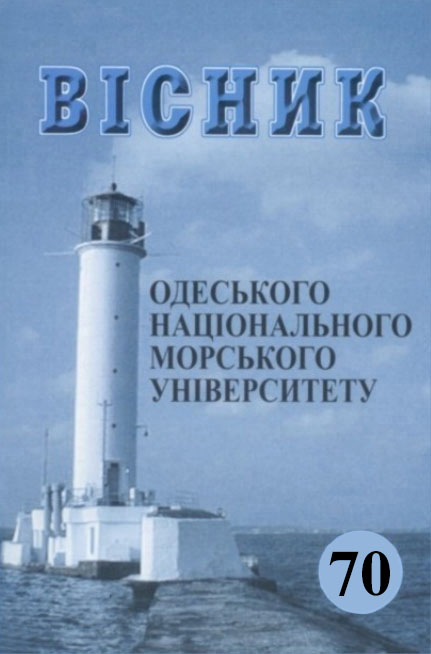Peculiarities of modeling processes of technical condition change with a component of randomness
Main Article Content
Abstract
Under the current conditions of cargo ships' operation, the problem of maintaining and optimizing the technical condition of ship's technical facilities is of relevance. At the same time, one of the important aspects is to consider random factors that may affect the efficiency and reliability of ships. This becomes especially relevant when it comes to large cargo ships making long voyages, where the probability of accidental damage or failure is high. The present article is devoted to the study of methods for modeling the processes of changes in the technical condition of shipboard technical equipment of cargo ships. The importance of the topic is due to the need to forecast and plan ship maintenance, which includes various components, including engines, hull, propulsion, navigation equipment, power equipment, etc. Analytical and statistical modeling methodologies are considered, and random operational factors acting in the interval between maintenance of ship's technical means are considered. The article determines that the tasks of modeling the processes of technical condition change include the analysis of the rate of change of technical condition, which reflects the dynamics of changes in the technical condition of cargo ship equipment and is an important indicator for planning and conducting maintenance. The article provides a comparative analysis of analytical and statistical modeling methodologies used to detail the patterns of technical condition variability, form models of regularities of evolution and accumulation of damage. The influence of random operational factors on the processes of technical condition change between maintenance of ship's technical means is investigated. It was found that random operational factors can cover various sea conditions, loads, weather conditions and other factors that affect the condition of the ship and its equipment between scheduled maintenance. The results of the study can be used to optimize the maintenance schedule based on the actual condition of the ship's equipment.
Article Details
References
2. Chong H.Y., Tan S.C., & Yap H.J. (2021). Hybridization of harmonic search algorithm in training radial basis function with dynamic decay adjustment for condition monitoring. Soft Computing, 25(15), 10221-10235. https://doi.org/10.1007/s00500-021-05963-3
3. Zhao J., Gao C., Tang T., Xiao X., Luo M., & Yuan B. (2022). Overview of Equipment Health State Estimation and Remaining Life Prediction Methods. Machines, 10(6), 422. https://doi.org/10.3390/machines10060422
4. Jenab K., Rashidi K., & Moslehpour S. (2013). An Intelligence-Based Model for Condition Monitoring Using Artificial Neural Networks. International Journal of Enterprise Information Systems, 9(4), 43-62. https://doi.org/10.4018/ijeis.2013100104
5. Oneto L., Anguita D., Coraddu A., Cleophas T.F., & Xepapa K. (2016). Vessel monitoring and design in industry 4.0: A data driven perspective. https://doi.org/10.1109/rtsi.2016.7740594
6. Ying-Yun H., Hao-Peng G., & Yu-Peng S. (2012). The Boundary Conditi- on’s Study and Application of Diesel Dynamics Analysis on Unsteady Wor- king Condition. https://doi.org/10.2991/mems.2012.44
7. Aqueveque P., Radrigan L., Pastene F., Morales A.S., & Guerra E. (2021). Data-Driven Condition Monitoring of Mining Mobile Machinery in Non- Stationary Operations Using Wireless Accelerometer Sensor Modules. IEEE Access, 9, 17365-17381. https://doi.org/10.1109/access.2021.3051583
8. Golovan A.I. (2023). Conceptual model of planning and optimization of cargo vessel maintenance schedules [Kontseptualna model planuvannia ta optymizatsii hrafikiv tekhnichnoho obsluhovuvannia vantazhnykh suden]. Vodnij Transport, 1(37), 41-49. https://doi.org/10.33298/2226-8553.2022.1.37.11 [in Ukrainian].
9. Golovan A., & Gritsuk I. (2023). The main principles of assessing the effi- ciency of ship maintenance [Osnovni pryntsypy doslidzhennia efektyv-nosti tekhnichnoho obsluhovuvannia sudna]. Transport development, 1(16), 47-60. https://doi.org/10.33082/td.2023.1-16.04 [in Ukrainian].
10. Jerrelind J., & Stensson A. (2000). Nonlinear dynamics of parts in enginee- ring systems. Chaos Solitons & Fractals, 11(15), 24132428. https://doi.org/10.1016/s0960-0779(00)00016-3
11. Golovan A., Honcharuk I., Deli O., Kostenko O., & Nykyforov Y. (2021). System of Water Vehicle Power Plant Remote Condition Monitoring. IOP Conference Series, 1199(1), 012049. https://doi.org/10.1088/1757-899x/1199/1/012049
12. Golovan A. (2023). Development of information support systems for maintaining the technical serviceability of Ukrainian merchant ships based on digital twins and real-time data analysis [Rozroblennia system informa- tsiinoho zabezpechennia pidtrymky tekhnichnoi prydatnosti suden torhovoho flotu Ukrainy na osnovi tsyfrovykh dviinykiv i analizu danykh v realnomu chasi] (0123U102159). https://nddkr.ukrintei.ua/view/rk/d1025734d23e9a0005f89ffa7dc9a215 [in Ukrainian].
